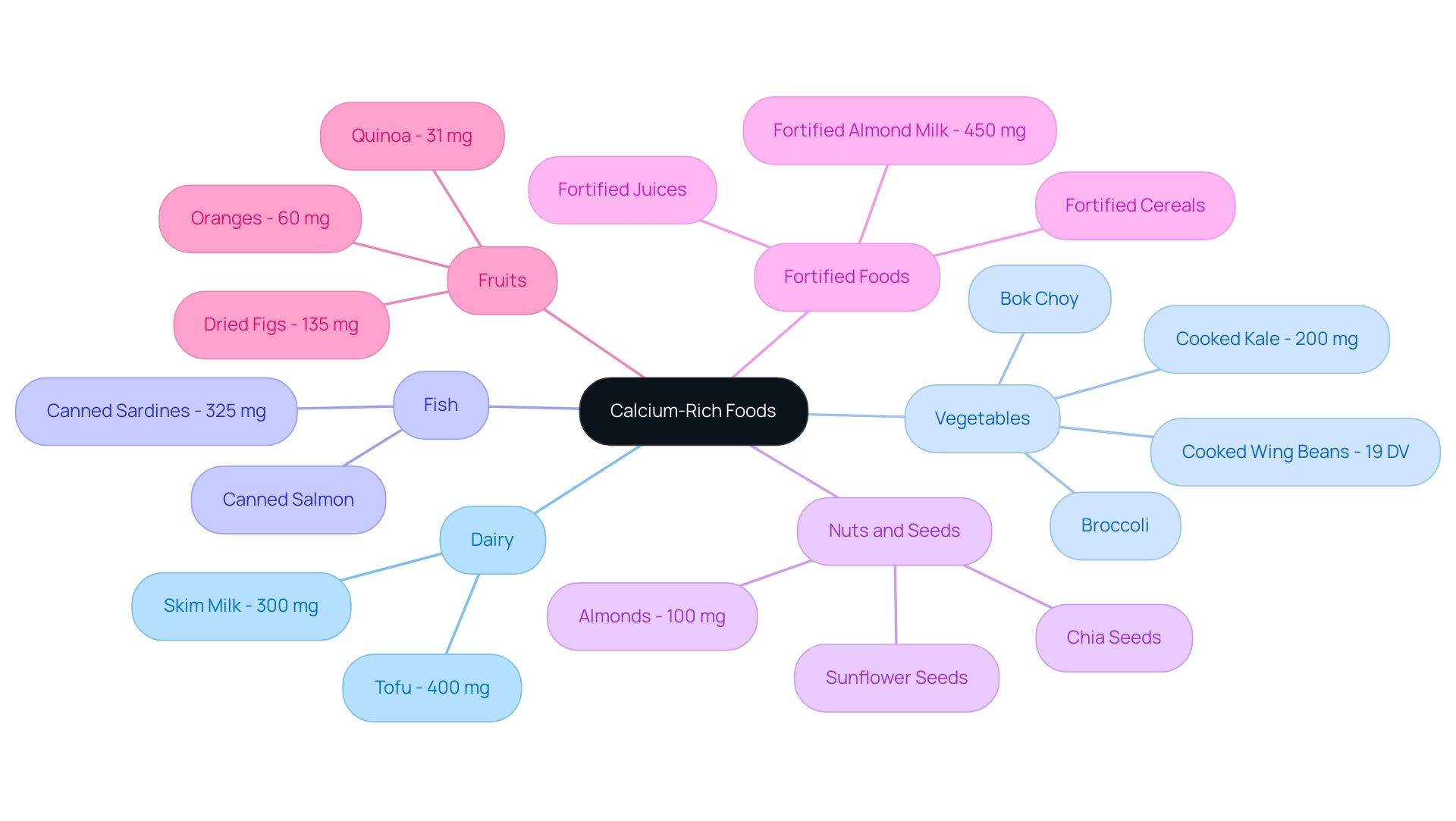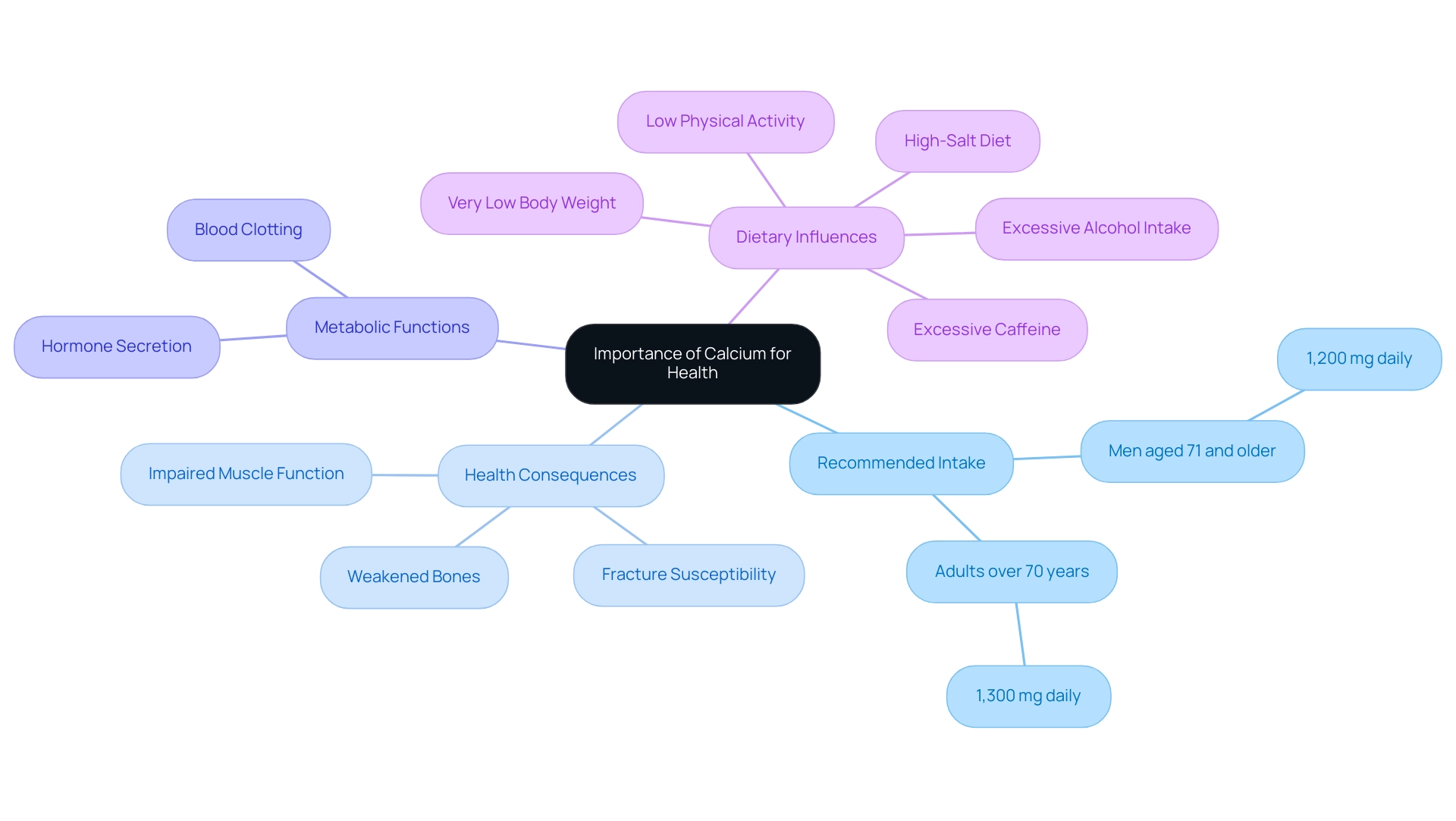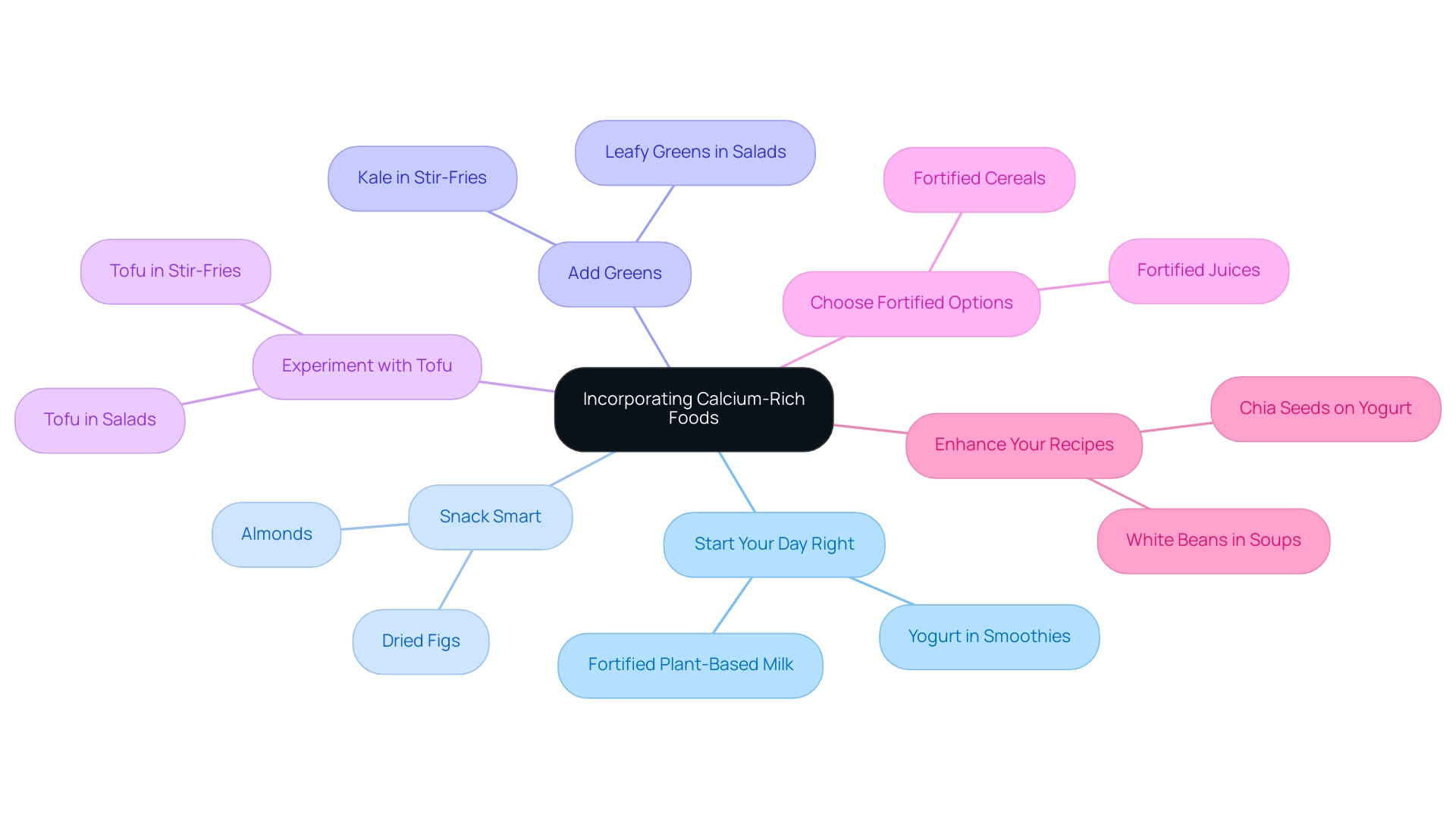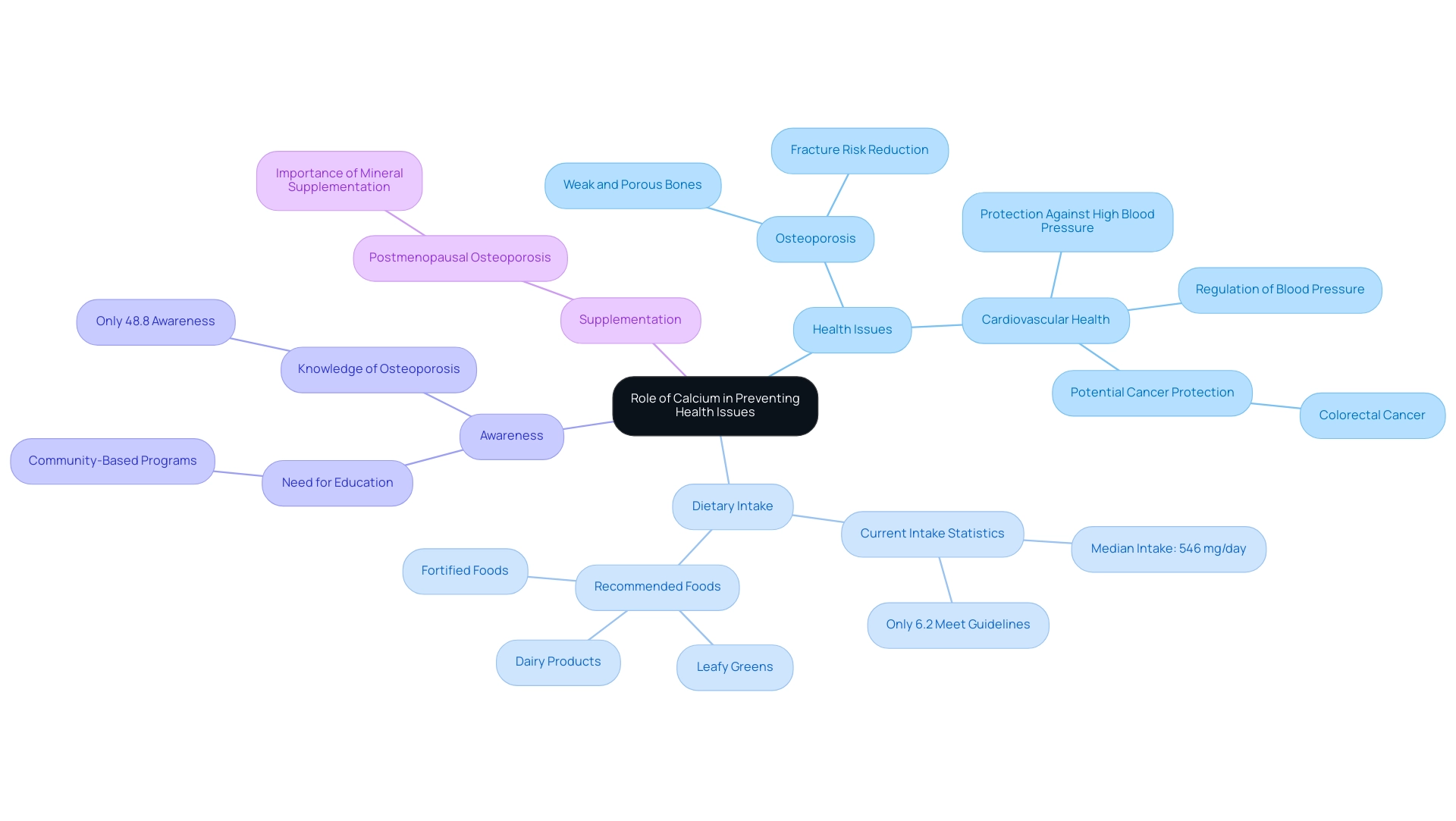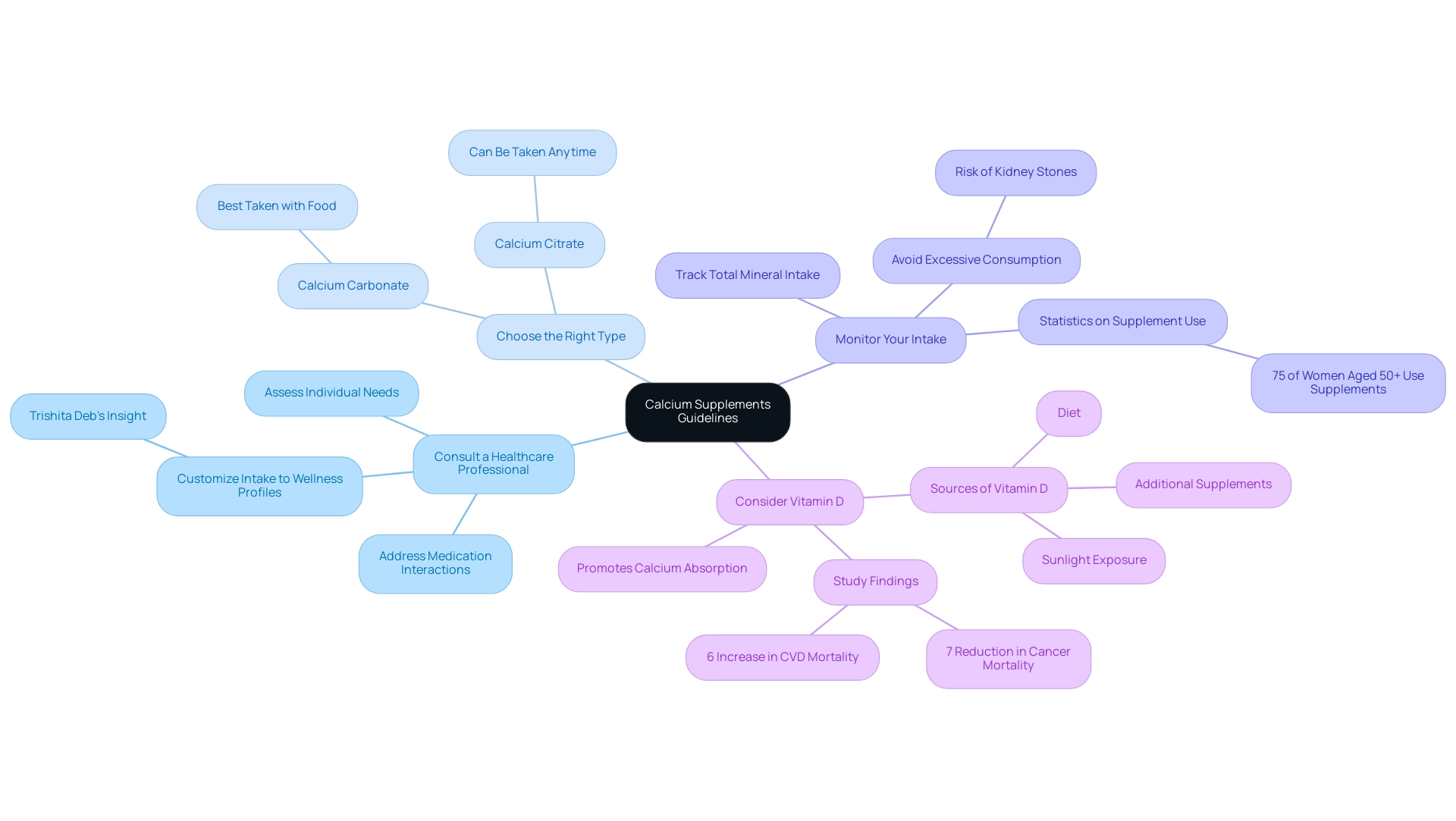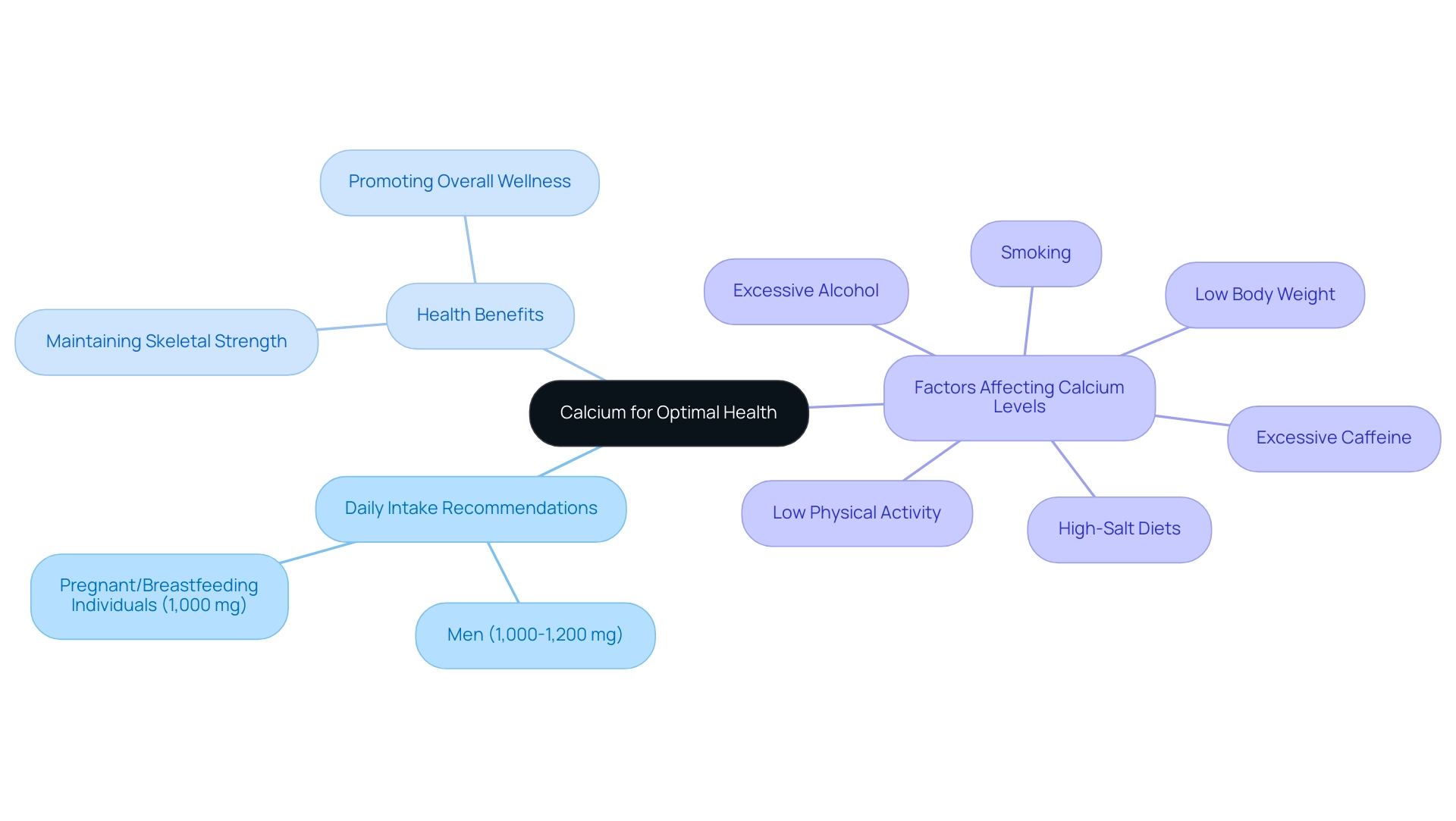Introduction
Calcium is a fundamental mineral that plays a crucial role in maintaining bone health and overall wellness. As populations age and dietary habits shift, understanding the importance of calcium-rich foods becomes increasingly vital. This article delves into the top sources of calcium, the significance of adequate intake for preventing health issues such as osteoporosis, and practical strategies for incorporating these foods into daily meals. By exploring the myths surrounding calcium consumption and the role of supplements, readers will gain a comprehensive understanding of how to optimize their dietary choices for better health outcomes.
1. Calcium-Rich Foods to Enhance Your Diet
Dairy products are considered calcium rich foods and remain one of the richest sources of this mineral, crucial for maintaining bone health. A cup of fortified skim milk is one of the calcium rich foods that offers roughly 300 mg of this mineral, making it a staple in many diets. Kerri-Ann Jennings, MS, RD, emphasizes the significance of dairy, noting that one cup (172 grams) of cooked wing beans delivers 19% of the DV for this mineral, while other varieties provide around 3–12% for the same serving size. Additionally, it's important to take mineral supplements at least 2 hours before or after taking quinolone antibiotics to ensure optimal absorption. Leafy vegetables such as kale, bok choy, and broccoli are excellent examples of calcium rich foods. For instance, one cup of cooked kale, which is among calcium rich foods, contains about 200 mg of this essential mineral, making it a valuable addition to any meal plan for those seeking non-dairy sources.
Fortified Foods: Many plant-based alternatives, including milks, cereals, and juices, are enriched with minerals to ensure adequate intake. A notable example of calcium rich foods is fortified almond milk, which can provide around 450 mg of this essential mineral per cup, catering to those who prefer non-dairy options.
Fish: Fish, especially canned types with bones like sardines and salmon, are abundant in minerals. A 3-ounce serving of canned sardines, which are considered calcium rich foods, contains approximately 325 mg of this mineral, showcasing how seafood can contribute significantly to nutrient intake.
Nuts and Seeds: Nuts and seeds, including almonds and chia, are not only nutritious but also considered calcium rich foods that provide a substantial amount of this essential mineral. A quarter-cup of almonds is considered one of the calcium rich foods, providing approximately 100 mg of a vital mineral, making them an easy addition to snacks or meals. Moreover, sunflower seeds also aid in mineral intake, with a serving providing a notable amount.
Tofu: Tofu is an excellent plant-based source of this nutrient, especially when prepared with calcium sulfate. Half a cup of tofu is one of the calcium rich foods that can yield up to 400 mg of this mineral, making it a versatile ingredient in various dishes.
White Beans: White beans are among the calcium rich foods, providing about 160 mg of calcium and a good amount of protein in one cup. This makes them a beneficial component of a balanced diet. Additionally, pea protein powder, derived from dried split peas, offers about 20 grams of protein per serving. A cup of dried split peas contains 45 grams of protein, making pea protein powder a great plant-based protein alternative that supports muscle health and overall well-being. Sufficient protein consumption is essential for maintaining bone density and overall health.
Oranges: While not a primary source of a certain mineral, one medium orange provides about 60 mg and adds a dose of vitamin C, enhancing overall nutritional value. Dried figs are a tasty method to enhance mineral levels, as five dried figs can be considered among calcium rich foods, providing around 135 mg of this nutrient. Quinoa, recognized as a complete protein, is a nutritious whole grain that provides approximately 31 mg of mineral content per cooked cup, making it a suitable addition to many calcium rich foods.
In summary, incorporating a range of calcium rich foods can significantly enhance mineral consumption and promote skeletal wellness. For personalized guidance on mineral intake, consider visiting the Nutrition Counseling Clinic at Parnassus, located at 400 Parnassus Avenue, San Francisco, CA, open Monday to Friday from 8 a.m. to 4:45 p.m. Recent studies continue to emphasize the significance of varied dietary sources of calcium, including the advantages of
soy protein and isoflavones in lowering blood cholesterol and reducing skeletal loss.
2. The Importance of Calcium for Bone Health and Overall Wellness
Consuming calcium rich foods is essential for preserving skeletal health and preventing osteoporosis, particularly as we grow older. It is essential not only for the development and upkeep of strong structures but also for the optimal functioning of muscles and nerves. The recommended dietary allowance (RDA) for this mineral varies by age and sex; for instance, men aged 71 and older require approximately 1,200 mg daily, while those over 70 should aim for a higher intake of about 1,300 mg per day.
Inadequate intake of this mineral can result in various health issues, including:
- Weakened bones
- Heightened fracture susceptibility
- Impaired muscle function
Furthermore, this mineral plays a vital role in various metabolic processes, such as blood clotting and hormone secretion, which are essential for overall well-being. Recent studies suggest that not consuming sufficient foods rich in minerals can indeed raise the
risk of kidney stone development, contradicting earlier advice to restrict dietary sources for prevention.
A large consumption of foods rich in minerals reduces the risk of kidney stones, whereas mineral supplements might elevate risk; certain dairy items demonstrated notable protective effects. Moreover, certain elements that can diminish mineral levels in your bones and decrease your bone density consist of:
- A high-salt diet
- Excessive caffeine and alcohol consumption
- Very low body weight
- Low amounts of physical activity
Thus, integrating calcium rich foods into your daily diet is an effective strategy to meet nutritional needs and foster a healthy lifestyle.
3. How to Incorporate Calcium-Rich Foods into Your Daily Meals
Incorporating calcium rich foods into your daily diet can be both simple and enjoyable. Here are some practical tips designed to enhance your calcium intake:
-
Start Your Day Right: Kick off your morning by including a serving of yogurt or fortified plant-based milk in your smoothie or cereal. This not only enhances your mineral levels but also offers essential nutrients to begin your day.
Snack smart by replacing typical snacks with calcium rich foods such as almonds or dried figs. These snacks are not only tasty but also helpful in boosting your mineral consumption between meals.
-
Add Greens: Leafy greens are among the calcium rich foods that serve as excellent sources of this mineral, with many containing between 10-60 mg per cup. Incorporate them into your salads, smoothies, or as a side dish. For instance, adding kale to your favorite stir-fry can enhance both the flavor and the nutritional value of your meal.
-
Experiment with Tofu: Tofu is a versatile ingredient that can be included in various dishes, from stir-fries to salads. Incorporating tofu enables you to boost your mineral intake without sacrificing taste, making it a wise addition to your diet.
-
Choose Fortified Options: Many cereals and juices are enhanced with this mineral. Choosing these products for your breakfast or snacks can significantly help you achieve your daily mineral goals. Always check labels to ensure that they contain adequate levels of the mineral.
-
Enhance Your Recipes: You can easily add white beans to soups and stews or sprinkle chia seeds on yogurt or oatmeal for an additional nutrient boost. These ingredients not only enhance the nutritional profile of your meals but also add texture and flavor.
These strategies correspond with recent suggestions highlighting the significance of this mineral for individuals susceptible to deficiency, especially women over 50, who may need to boost their consumption to help prevent osteoporosis, as emphasized in the case study titled '
Nutritional Recommendations for Women Over 50.' According to the U.S. Department of Agriculture, it is essential that most mineral intake should come from dietary sources, reinforcing the need for these practical dietary adjustments.
4. The Role of Calcium in Preventing Health Issues
Guaranteeing sufficient levels of this mineral is crucial for the avoidance of various medical problems, particularly osteoporosis, a condition characterized by weak and porous bones. Insufficient mineral consumption is acknowledged as a public concern, especially in areas with poor dietary intake. Research indicates that individuals who maintain adequate intake of this mineral throughout their lives exhibit a significantly reduced risk of developing osteoporosis and experiencing related fractures.
Furthermore, this mineral is essential for cardiovascular health, as it aids in regulating normal blood pressure levels. Recent research has indicated that ideal consumption of this mineral may also have a protective effect against issues like high blood pressure and specific types of cancer, including colorectal cancer. Alarmingly, a study titled 'Knowledge and Attitude Regarding Osteoporosis Among Young Malaysian Chinese' revealed that participants aged 18 to 26 years had a median calcium intake of only 546 mg/day, well below the Recommended Nutrient Intake, with just 6.2% meeting the dietary guidelines.
Significantly, the study revealed that participants showed limited knowledge about osteoporosis, with only 48.8% displaying sufficient awareness, highlighting the urgent need for
community-based education programs aimed at increasing osteoporosis awareness among young adults. By prioritizing calcium rich foods like dairy products, leafy greens, and fortified foods in one's diet, individuals can significantly enhance their long-term health and well-being. As highlighted by Gordon Guyatt in his meta-analysis, mineral supplementation is essential for the prevention of postmenopausal osteoporosis, reinforcing the need for individuals to be proactive about their mineral intake.
5. Understanding Calcium Supplements: When and How to Use Them
For individuals who find it challenging to meet their mineral requirements through dietary sources alone, supplements may serve as an effective alternative. Nonetheless, careful consideration is crucial. Here are essential guidelines to follow:
-
Consult a Healthcare Professional: It is vital to consult with a healthcare provider prior to initiating any supplementation regimen.
This step allows for an assessment of individual calcium needs and ensures that any potential interactions with existing medications are addressed. Experts emphasize, it is important to customize supplement intake to personal wellness profiles, highlighting the necessity of professional guidance.
Trishita Deb, a market research analyst with over 8 years of experience, notes that understanding personal health needs is key to effective supplementation.
-
Choose the Right Type: Supplements containing this mineral are available in various formulations, such as carbonate and citrate. Calcium carbonate is best taken with food, improving its absorption, while citrate can be consumed at any time, with or without meals. Understanding these differences is essential for maximizing effectiveness.
-
Monitor Your Intake: Careful tracking of total mineral intake—encompassing both dietary sources and supplements—is crucial to avoid surpassing the recommended daily allowance. Excessive consumption of the mineral can lead to adverse health effects, including the formation of kidney stones. Current statistics suggest that 75% of women aged 50 and above are regular dietary supplement users, which underscores the importance of mindful consumption.
-
Consider Vitamin D: Many supplements for this mineral are formulated with vitamin D, which is known to promote absorption of it. Ensuring adequate vitamin D levels—whether through diet, sunlight exposure, or additional supplements—is essential for maximizing the advantages of mineral supplementation. Significantly, a study titled 'Impact of Calcium and Vitamin D Supplementation on Outcomes' found a 7% reduction in cancer mortality among participants receiving supplements, indicating potential benefits that extend beyond bone well-being.
Overall, adhering to these guidelines can help individuals safely incorporate mineral supplements into their health regimen.
6. Common Myths About Calcium
Numerous myths about this mineral can mislead individuals in their dietary choices, often resulting in inadequate intake or poor nutritional habits. Below are several prevalent misconceptions, along with the corresponding truths:
-
Myth 1: Only dairy products contain calcium.
Fact: While dairy products like milk, cheese, and yogurt are significant sources, many calcium rich foods also offer substantial amounts of this essential mineral. Leafy greens, like kale and bok choy, fortified foods (such as certain plant-based milks and cereals), and calcium rich foods, including fish with bones like sardines and salmon, offer significant amounts of this mineral, making it accessible to those who do not consume dairy. For instance, one cup of skim, low-fat, or whole milk has approximately 300 mg of this mineral, demonstrating the nutrient's significance in typical dietary sources.
-
Myth 2: You can obtain sufficient mineral from supplements alone.
Fact: Although mineral supplements can help fill dietary gaps, they should not substitute whole foods. Whole foods are considered calcium rich foods that provide not only calcium but also a range of other vital nutrients functioning together to enhance overall well-being. A balanced diet is essential for attaining optimal nutritional status, and it is advised to restrict foods high in added sugars, saturated fat, and sodium to promote overall well-being.
-
Myth 3: Calcium is only important for children and older adults.
Fact: Calcium rich foods are essential for individuals at every stage of life. It supports bone condition, muscle function, and nerve signaling, contributing to overall wellness. The
World Health Organization advises that expectant mothers with low dietary levels of the mineral consume between 1,500 and 2,000 mg of it daily to lower the risk of preeclampsia, emphasizing the nutrient's significance even during pregnancy.
Moreover, a case study named "Calcium Intake and Metabolic Syndrome Risk" discovered that women with greater dietary intake experienced a 27% reduced risk of metabolic syndrome, highlighting the importance of sufficient mineral consumption for women's well-being.
By addressing these myths and incorporating relevant statistics and studies, individuals can make more informed dietary choices that adequately support their needs for this essential mineral.
7. Conclusion: Prioritize Calcium for Optimal Health
Including calcium rich foods in your diet is essential for maintaining skeletal strength and promoting overall wellness. Current guidelines suggest that men intake between 1,000 to 1,200 mg of this mineral daily, while
pregnant and breastfeeding individuals should aim for 1,000 mg per day to support both their health and that of their children. A diet abundant in minerals can lessen the dangers linked to elements that decrease skeletal density, such as excessive caffeine, high-salt diets, and low physical activity levels.
Health specialists highlight the significance of prioritizing this mineral in your meals, stressing that certain elements that can diminish its presence in your bones include excessive alcohol consumption, very low body weight, and smoking.
The National Osteoporosis Foundation and the American Society for Preventive Cardiology endorse the notion that additional mineral intake is safe for generally healthy individuals, provided total consumption does not exceed recommended levels. Their examination of literature, featuring four randomized controlled trials and 26 prospective cohort studies, determined that addressing dietary deficiencies with mineral supplements can be a safe and effective approach without compromising cardiovascular well-being.
By making calcium rich foods a priority in your daily diet, you can take proactive steps towards a healthier lifestyle and potentially enhance long-term wellness outcomes. Consulting with a healthcare professional can provide personalized guidance tailored to your specific dietary needs. Embrace the benefits of calcium rich foods to bolster your health for years to come.
Conclusion
Incorporating calcium-rich foods into the daily diet is essential for maintaining bone health and overall wellness. The article highlights a variety of excellent sources, including:
- Dairy products
- Leafy greens
- Fortified foods
- Fish
- Nuts
- Seeds
Each of these foods contributes significantly to meeting the recommended dietary allowance for calcium, which varies by age and sex. Adequate calcium intake is vital not only for bone development and maintenance but also for the optimal functioning of muscles and nerves, as well as the prevention of health issues such as osteoporosis and cardiovascular disease.
Practical strategies for enhancing calcium intake are also discussed, emphasizing the importance of integrating these foods into daily meals. Whether through:
- Starting the day with fortified milk
- Snacking on almonds
- Adding leafy greens to dishes
small changes can lead to substantial health benefits. Furthermore, the article addresses common misconceptions surrounding calcium, clarifying that non-dairy sources can provide sufficient calcium and that whole foods should be prioritized over supplements.
Ultimately, prioritizing calcium in the diet is a proactive approach to fostering long-term health. By making informed dietary choices and seeking guidance when necessary, individuals can significantly reduce their risk of health complications related to inadequate calcium intake. Embracing a calcium-rich diet is a straightforward yet powerful step towards enhancing overall well-being and ensuring robust bone health for years to come.
